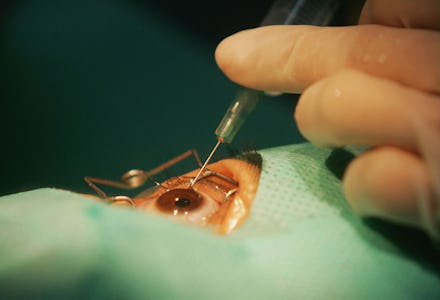These New Contact Lenses Let You Zoom In with Just a Wink

Researchers may have found a way to "trick out" a contact lens — and it's about more than just looking cool.
CNN reports that a Swiss team is developing a device that could improve the vision of those with age-related macular degeneration (AMD), a condition in which a small region of the eye called the macula slowly deteriorates, eventually causing loss of vision in one or both eyes.
What's more, they work with a wink.
The device: The device is basically a contact lense with a tiny telescope attached. The researchers tweaked a contact lens, only 1.55 millimeters thick, by placing a telescope made of mirrors and filters within it. These modifications increase the lens' reflective powers and precisely mirrors light to enlarge images.
By wearing these lenses, someone with AMD has more seeing power to focus on things like the face of a passing stranger, words on a page while reading or writing or oncoming traffic while driving.
The old switcheroo. Making it easier for someone with AMD to see up-close images is only half the solution — they also need to be able to see the big picture. For a person with normal eyesight, focusing on one object, while still being able to see others is a no brainer. But, for people with AMD, being able to focus might mean not being able to see anything else.
The researchers wanted to get around this problem by designing a lens that would let someone see objects directly in front of them and also switch back to regular vision — think zooming in and then zooming out. So, with every pair of contact lens, comes a complementary pair of battery-powered glasses that sense when a wearer winks and switches modes in response.
"Having the ability to switch on demand is attractive," Eric Tremblay, co-creator and research scientist and at EPFL in Switzerland told CNN. "When magnified you lose a lot of your field of view, your peripheral vision,"
According to the CNN report, the team, which is still working to improve the device, revealed its latest prototype in February. The newest version was updated to allow oxygen to pass through the lens. So far, they've tested the tool out on a few persons to measure for comfort but their main goal is to create a lens that could be worn daily.
Through the looking glass. This isn't the first time scientists have approached solving issues of eye-care from behind a lens and it likely won't be the last. Last January, a researcher at Harvard Medical school took on the challenge of creating a lens that released glaucoma medication.
One of the biggest challenges these researchers face is compliance. The eye is a delicate organ, so every such device must face rigorous testing to ensure they don't inflict any irreparable damage. Adding objects to a lens could lead to even more tinkering and developments in this branch of research. Although it might be a little too early to hope for laser vision.
About 1.8 million Americans have AMD according to the Centers for Disease Control and Prevention and with no cure for the condition available, the new device could be big news for improving the vision of sufferers. Since the CDC projects that by 2020, approximately 2.9 Americans will suffer from AMD, not only is there a wide open market for a novel device, but there is clearly a public need for one.